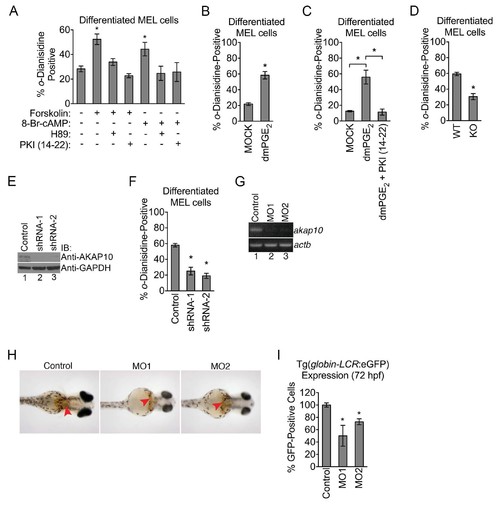- Title
-
Erythropoietin signaling regulates heme biosynthesis
- Authors
- Chung, J., Wittig, J.G., Ghamari, A., Maeda, M., Dailey, T.A., Bergonia, H., Kafina, M.D., Coughlin, E.E., Minogue, C.E., Hebert, A.S., Li, L., Kaplan, J., Lodish, H.F., Bauer, D.E., Orkin, S.H., Cantor, A.B., Maeda, T., Phillips, J.D., Coon, J.J., Pagliarini, D.J., Dailey, H.A., Paw, B.H.
- Source
- Full text @ Elife
|
Mitochondrial outer membrane PKA signaling is required for erythropoiesis. (A–C) o-dianisidine staining for hemoglobinized MEL cells treated with several pharmacologic modulators of PKA activity. (A) PKA activation with 8-Br-cAMP or high-dose forskolin (50 µM) triggers an increase in heme production that is blocked by H89 or PKI (14-22) treatment at day 3 of DMSO induction. (B and C) A similar increase in hemoglobinization was observed with dMPGE2 that was also inhibited by PKI (14-22). (D) Wild-type (WT) or AKAP10-knockout (KO) erythroid cells at day 4 of differentiation were stained with o-dianisidine. (E and F) AKAP10 expression was knocked-down using two different shRNAs (E) that lead to reduced hemoglobinization (F). (G–I) akap10-specific morpholinos (MOs) were used to inhibit akap10 expression in zebrafish embryos (G). These morphants were anemic with reduced hemoglobinization (H) and red blood cell counts (I). *p-value<0.05, Mean ± SEM, n = 3. All immunoblots were performed twice. 8-Br-cAMP-8-bromoadenosine 3’,5’-cyclic monophosphate; dmPGE2-dimethyl-prostaglandin E2; WT-wild-type; KO-knockout; shRNA-short hairpin RNA; MO-morpholino; IB-immunoblot. PHENOTYPE:
|

